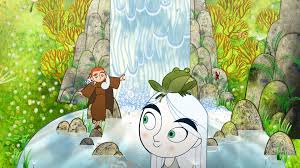Review: Secret of Kells March 31, 2013
Author: Beach Combing | in : Actualite , trackbackPart of being a twenty-first century parent involves the ability to watch cartoons repeatedly with your children (discuss). Most of these cartoons are trash. A minority are witty: Mega Mind, Toy Story… And a handful – Shrek, Bambi, Totoro, Kiki the Witch… – make modern art house films look like third-rate romantic comedies: they really are outstanding. Beach thought he would celebrate Easter by briefly giving vent to his enthusiasm over one of the very best: The Secret of Kells. It has fairies, it has palaeography and it is even rude about the Vikings. What’s not to like?
Admittedly The Secret of Kells doesn’t have very promising credentials. It was a Belgian-Irish-French production (!!!). It involves some easy plugs into early medieval Irish culture: that damn pangur poem, Colum Cille and the greatest relic of ‘the golden age’, the Book of Kells itself. Of course, Christianity and paganism get hopelessly mixed up: isn’t that always the way in early medieval Ireland, or at least isn’t that always the way that Belgian-Irish-French productions portray things?
But actually against all odds it works. The key to its success are three-fold. First, there is something rather intransigent and politically incorrect about its director’s values. If you told most production companies – particularly French-Belgian-Irish production companies – to do a film about the Viking age in Ireland it would include a Viking orphan and an Irish waif and in the end both cultures would come to a greater understanding of the benefit of working together. Aaarrgh!!! TSoK portrays those bastards from the north as robotic killing machines who hang out with ravens and who murder babies. There is not a single positive Viking scene in the whole film: Odin be praised! The producers aren’t much kinder about paganism either, though the fairy, Aisling takes the edge off that.
Second, there is that very dangerous mix of humour and profundity that sink most attempts at history, but that here work. The eight-year-old hero Brendan is funny and brave by turns. And in his story of growing up there is the most important thing in any coming of age tale: loss as represented in this case by the fairy girl, Aisling, who turns into a wolf and his idol, the illustrator Aidan and who disappears into the waves. Note that if you go and look for fairies in films you won’t find a better fairy than this albino: in fact, films and fairies don’t mix very well. The most memorable scene that comes to Beach’s mind involves a leprechaun and Jennifer Aniston in a questionable sex act. Others: drbeachcombing At yahoo DOT com
Third, Beach is not going to be able to do justice to this, but the illustrations are beautiful… simply extraordinary. They are not convincing, they are not realistic, they are not symmetrical and yet they are alive with cardboard cutouts vibrating like real individuals, save, of course, the Vikings that rock back and forwards like daleks, bless them. The end is pretty fabulous too…
Beach has watched this film about six times now with different children, as it is so much better than sitting down to Pocha-sodding-hontas yet again. He’s found that from two to four there is basic incomprehension, but the colours and the cat holds the child’s attention. From four to six there is interest and frequent questions and how nice to be able to tell kids the truth about the Vikings. Then, from six to eight, there are tears, hand-holding and fear. That tells you all you really need to know about TSOK.
Happy Easter and sorry about lack of emails to readers been a tough period…



